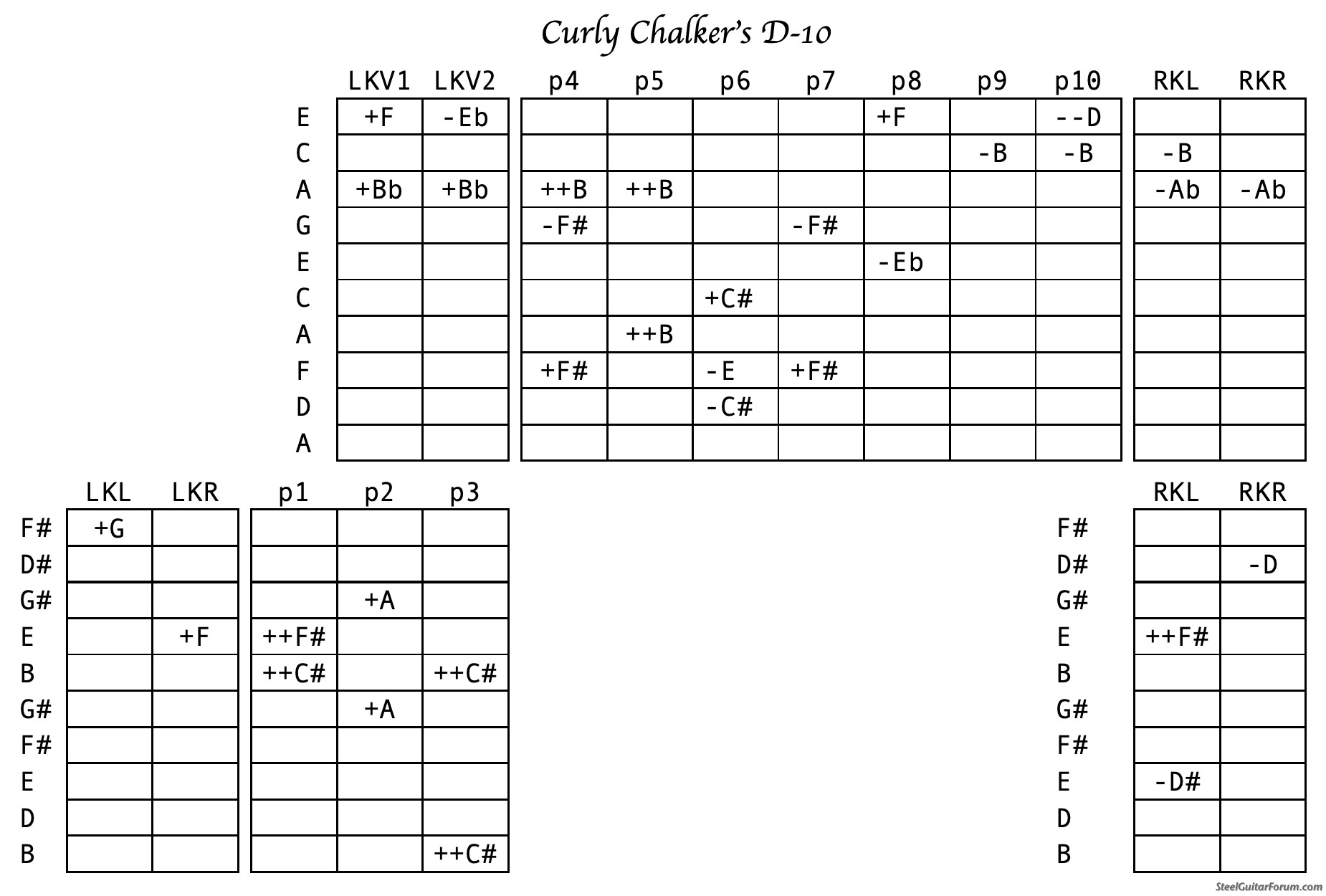I thought it might be interesting to some folks.
I am sure that I at one time or another read everything that I included, but I did not make a note of who wrote what, and could have made some mistakes since I am no expert, just a fan.
I welcome any corrections or additions
Early Fifties
With Hank Thompson Curly was playing a three neck Fender Custom, on tracks like:
Wild Side of Life
https://www.youtube.com/watch?v=3nwiwiGKGfk
Crying in the Deep Blue Sea
https://www.youtube.com/watch?v=scMYykZbBto
Curly Chalker already developed an amazing style, especially on C6th tuning, with the single note and chord chop ferocity of Joaquin Murphey, and smooth slants and volume pedal technique of Jerry Byrd, who Curly greatly admired.
good thread about non-pedal Curly with more examples:
https://be.steelguitarforum.com/viewtop ... 7824d53859
Mid Fifties
After this, Curly started using a quad neck long scale (1953, 1954?) Fender Stringmaster
In this clip from 1955, can see him play a solo on that guitar:
https://www.youtube.com/watch?v=CMMzwQi07vs
He plays in a practically perfect copy of the high energy Speedy West style, complete with bar slams and tone control boo-wahs.
The tuning is likely some kind of F#9th or F#13th tuning neck, and has reentrant high strings on the bottom.
c.1956 - c.1965
Curly then got a Fender 1000, double 8 pedal steel (big Jazzmaster style single coil pickups)
These were white, and at some point his was painted red.
Curly played with two Fender Bassman amps.
He played this guitar for about 10 years, and began developing his C6th copedent.
On all his pedal steels, Curly had the C6th neck in the front, with the E9th tuning in the closest position.
Here are the copedents he used on his Fender 1000 from a Fender document from the early 60s, courtesy of Herb Steiner:

Already you can see some of the more unique aspects of his C6th copedent, including getting B and D by lowering the high E and C strings, rather than raising the C and A strings like the "conventional" C6th P7.
The other neck is the Leon McAuliffe E13th tuning tuned up a half step. P1 is the "Bud Isaacs" unsplit A and B early E9th pedal sound.
P2 alone gives an F9th (with a similar voicing to the forgotten non-pedal A9th tuning used by pros like Jody Carver).
P1 and P2 together gives a pretty Eb maj 7th voicing on the top 6 strings.
Examples using the Fender 1000:
Merle Travis - Travis! album:
https://www.youtube.com/playlist?list=P ... hsNF7avUIS
Hank Thompson - Stirring Up the Ashes:
https://www.youtube.com/watch?v=Jz58afPAQt4
Bill Bledsoe - Tell Me Why:
https://www.youtube.com/watch?v=J-kf1v8vKic
Bill Bledsoe - That Same Old Feeling:
https://www.youtube.com/watch?v=mOCL2sih-tg
c. 1965-1966
In this period, Curly was based in Las Vegas when not touring, and had a steady gig there playing steel guitar and trumpet.
Around this time Curly got a Fender 2000, which was Fenders new double 10 string (skinny, Jaguar style pickups).
He was one of the last real pros to move up to 10 strings.
This guitar was custom color sherwood green. Tommy Morrell later had this guitar and it got burned up in a house fire in which he lost many other precious items and his home.
Extending to 10 strings, Curly decided to add to the bottom. To the E C A G E C A F 8 string tuning, he added a low D, and then a very low A.
Hal Rugg and Big Jim Murphy also tuned their C6th like this around that time, but they both later switched.
He recorded Big Hits On Big Steel using this guitar, even though he is pictured on the front with a Sho-Bud:
https://www.youtube.com/watch?v=rOYVHsfb6r4
1966
In 1966, Curly Chalker moved to Nashville from Las Vegas. He changed to a Sho-Bud guitar, and ditched the Fender.
But even later on, Curly Chalker spoke highly about Fender equipment and he said they were good to him.
One factor that might be related: I read here on this forum that there was a big anti Fender pedal steel stigma at that time in Nashville, and that the first thing you would get asked for a job is what kind of steel you had, not whether you could play!
Fender also did too little too late as far as their pedal steel product line, not having 10 strings until 1964, and no knee levers.
That was also around the time of the CBS takeover who wanted to streamline everything, and the fact that practically everyone who ordered a Fender pedal steel wanted a different tuning set up did not fit with their mass production corporate philosophy.
Anyway, his Sho-Bud was supposedly the first pedal steel ever to use vertical levers, which were for his left leg for his C6th tuning.
He wanted verticals instead of conventional sideways levers because he wanted his leg to be free to hit the C6th pedals, as he almost always kept his foot on the volume pedal and rarely if ever used two feet.
These verticals were a (relatively open) secret and gave him some very nice altered sounds.
He also added two A to Ab right knees on his C6th which became a big part of his sound.
Also at this time Curly learned (at first reluctantly, according to Mr. Lloyd Green) the E9th tuning.
Lloyd encouraged him, and Curly of course soon developed a great, soulful style on the E9th neck.
Lloyd said that Curly later confided to him that there was a lot of going on in the E9th tuning after all.
Curly Chalker's D10 copedent:
